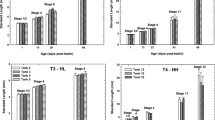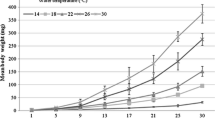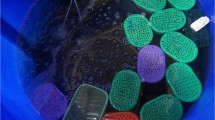Abstract
Barbel larvae were reared for 21 days at 21.0, 24.1, 27.2 or 30.0 °C and fed ad libitum live Artemia nauplii for 16 h a day. The final survival rates exceeded 99 %. The highest mean daily growth rates, amounting to 0.97 mm total length (TL) and 17.3 % body weight (BW), were found at 27.2 °C. The optimum temperature calculated for the growth of larvae was 26.9 °C for TL and 26.5 °C for BW. An increase in water temperature accelerated the development rate to a larger degree than the growth rate. Temperature significantly influenced the final fish body chemical composition. The lowest dry matter content (19.1 %) was found at 24.1 °C. The highest values of ash content were determined for 27.2 and 30.0 °C and were 11.3 and 11.0 % of dry matter, respectively. The fish body caloric value was the highest at 30.0 °C (30.0 J mg−1). The analysis of changes in the fish body chemical features against the effective day-degrees age scale did not reveal significant influence of temperature. Therefore, the effects of temperature on larval body composition seem to be related mainly to differences in barbel developmental progress at particular temperatures.





Similar content being viewed by others
Abbreviations
- TL:
-
Total length
- BW:
-
Body weight
- OGT:
-
Optimum temperature for growth
- ITL:
-
Daily increment in total length
- RGR:
-
Relative growth rate
- cal.val.:
-
Caloric value
- D°eff. :
-
Effective day-degrees
References
Alavi SMH, Pšenička M, Policar T, Linhart O (2008a) Morphology and fine structure of Barbus barbus (Teleostei: Cyprinidae) spermatozoa. J Appl Ichthyol 24:378–381
Alavi SMH, Pšenička M, Rodina M, Policar T, Linhart O (2008b) Changes of sperm morphology, volume, density and motility and seminal plasma composition in Barbus barbus (Teleostei: Cyprinidae) during the reproductive season. Aquat Living Resour 21:75–180
Alavi SMH, Pšenička M, Policar T, Rodina M, Kozák P, Linhart O (2008c) Sperm characteristics in Barbus barbus as a function of nutrition throughout the reproductive season. Cybium 32:200–201
Alavi SMH, Pšenička M, Policar T, Rodina M, Hamáčková J, Kozák P, Linhart O (2009a) Sperm quality in male Barbus barbus L. fed different diets during the spawning season. Fish Physiol Biochem 35:683–693
Alavi SMH, Rodina M, Policar T, Linhart O (2009b) Relationship between semen characteristics and body size in Barbus barbus L. (Teleostei: Cyprinidae) and effects of ions and osmolality on sperm motility. Comp Biochem Physiol A 153:430–437
Atkinson D (1994) Temperature and organism size—a biological law for ectotherms? Adv Ecol Res 25:1–58
Atkinson D (1995) Effects of temperature on the size of aquatic ectotherms: exceptions to the general rule. J Therm Biol 20:61–74
Atkinson D, Sibly RM (1997) Why are organisms usually bigger in colder environments? Making sense of a life history puzzle. Trends Ecol Evol 12:235–239
Baras E, Philippart JC (1999) Adaptive and evolutionary significance of a reproductive thermal threshold in Barbus barbus. J Fish Biol 55:354–375
Björnsson B, Tryggvadóttir SV (1996) Effects of size on optimal temperature for growth and growth efficiency of immature Atlantic halibut (Hippoglossus hippoglossus L.). Aquaculture 142:33–42
Björnsson B, Steinarsson A, Oddgeirsson M (2001) Optimal temperature for growth and feed conversion of immature cod (Gadus morhua L.). ICES J Mar Sci 58:29–38
Brett JR, Shelbourn JE, Shoop CT (1969) Growth rate and body composition of fingerling sockeye salmon, Oncorhynchus nerka, in relation to temperature and ration size. J Fish Res Bd Can 26:2363–2394
Briolay J, Galtier N, Brito RM, Bouvet Y (1998) Molecular phylogeny of Cyprinidae inferred from cytochrome b DNA sequences. Mol Phylogenet Evol 9:100–108
Choa BY, Carter CG, Battaglene SC (2010) Effects of temperature regime on growth and development of post-larval striped trumpeter (Latris lineata). Aquaculture 305:95–101
Elliott JM (1975) The growth rate of brown trout (Salmo trutta L.) fed on maximum rations. J Anim Ecol 44:805–821
Fiala J, Spurný P (2001) Intensive rearing of the common barbel (Barbus barbus L.) larvae using dry starter feeds and natural diet under controlled conditions. Czech J Anim Sci 46:320–326
Fonds M, Cronie R, Vethaak AD, Van der Puyl P (1992) Metabolism, food consumption and growth of plaice (Pleuronectes platessa) and flounder (Platichthys flesus) in relation to fish size and temperature. Neth J Sea Res 29:127–143
Hancock RS, Jones JW, Shaw R (1976) A preliminary report on the spawning behaviour and nature of sexual selection in the barbel, Barbus barbus (L.). J Fish Biol 9:21–28
Handeland SO, Imsland AK, Stefansson SO (2008) The effect of temperature and fish size on growth, feed intake, food conversion efficiency and stomach evacuation rate of Atlantic salmon post-smolts. Aquaculture 283:36–42
Horváth L, Szabó T, Burke J (1997) Hatchery testing of GnRH analogue-containing pellets on ovulation in four cyprinid species. Pol Arch Hydrobiol 44:221–226
Imsland AK, Sunde LM, Folkvord A, Stefansson SO (1996) The interaction of temperature and fish size on growth of juvenile turbot. J Fish Biol 49:926–940
Imsland AK, Foss A, Sparboe LO, Sigurdsson S (2006) The effect of temperature and fish size on growth and feed efficiency ratio of juvenile spotted wolffish Anarhichas minor. J Fish Biol 68:1107–1122
Imsland AK, Schram E, Roth B, Schelvis-Smit AAM, Kloet K (2007) Improving growth in juvenile turbot (Scophthalmus maximus Rafinesque) by rearing fish in switched temperature regimes. Aquacult Int 15:403–407
Jobling M (1994) Fish bioenergetics. Chapman & Hall, London
Jonassen TM, Imsland AK, Stefansson SO (1999) The interaction of temperature and fish size on growth of juvenile halibut. J Fish Biol 54:556–572
Jonsson B, Jonsson N (2009) A review of the likely effects of climate change on anadromous Atlantic salmon Salmo salar and brown trout Salmo trutta, with particular reference to water temperature and flow. J Fish Biol 75:2381–2447
Kamiński R, Kamler E, Wolnicki J, Sikorska J, Wałowski J (2010) Condition, growth and food conversion in barbel, Barbus barbus (L.) juveniles under different temperature/diet combinations. J Therm Biol 35:422–427
Kamler E (1992) Early life history of fish: an energetics approach, fish and fisheries series, 4. Chapman & Hall, London
Kamler E (2002) Ontogeny of yolk-feeding fish: an ecological perspective. Rev Fish Biol Fish 12:79–103
Kamler E (2008) Resource allocation in yolk-feeding fish. Rev Fish Biol Fish 18:143–200
Kamler E, Szlamińska M, Kuczyński M, Hamáčková J, Kouřil J, Dąbrowski R (1994) Temperature-induced changes of early development and yolk utilization in the African catfish Clarias gariepinus. J Fish Biol 44:311–326
Katersky RS, Carter CG (2007) High growth efficiency occurs over a wide temperature range for juvenile barramundi (Lates calcarifer) fed a balanced diet. Aquaculture 272:444–450
Kottelat M, Freyhof J (2007) Handbook of European freshwater fishes. Kottelat, Cornol, Switzerland and Freyhof, Berlin, Germany
Kouřil J, Filla V, Sandera K, Barth T, Flegel M (1988) Hormonally induced stripping of the female barbel (Barbus barbus L.) using carp pituitary and LH-RH analogue. Bull VURH Vodnany 3:18–25
Kujawa RJ (2004) Biologiczne podstawy podchowu larw reofilnych ryb karpiowatych w warunkach kontrolowanych. University of Warmia and Mazury in Olsztyn, Olsztyn 88
Kujawa R, Kucharczyk D, Mamcarz A, Skrzypczak A (1998) The rearing methods of barbel (Barbus barbus L.) on artificial diets under controlled conditions. Eur Aquacult Soc Spec Publ 26:155–156
Myszkowski L (1997) Pitfalls of using growth rate coefficients. Pol Arch Hydrobiol 44:389–396
Pedersen T, Jobling M (1989) Growth rates of large, sexually mature cod Gadus morhua, in relation to condition and temperature during an annual cycle. Aquaculture 81:161–168
Peňáz M (1973) Embryonic development of the barb, Barbus barbus (Linnaeus, 1758). Zool Listy 22:363–374
Philippart JC (1982) Mise au point de l’alevinage contrôlé du barbeau Barbus barbus (L.) en Belgique. Perspectives pour le rempoissonnement des rivières. Cah Ethol Appl 2:173–202
Philippart JC, Mélard C, Poncin P (1989) Intensive culture of the common barbel, Barbus barbus (L.) for restocking. In: De Pauw N, Jaspers E, Ackefors H, Wilkins N (eds) Aquaculture: a biotechnology in progress. Belgium, EAS, Bredene, pp 483–491
Policar T, Kozák P, Hamáčková J, Lepičová A, Musil J, Kouřil J (2007) Effects of short-time Artemia spp. feeding in larvae and different rearing environments in juveniles of common barbel (Barbus barbus) on their growth and survival under intensive controlled conditions. Aquat Living Res 20:175–183
Policar T, Podhorec P, Stejskal V, Hamackova J, Alavi SMH (2010) Fertilization and hatching rates and larval performance in captive common barbel (Barbus barbus L.) throughout the spawning season. J Appl Ichthyol 26:812–815
Policar T, Podhorec P, Stejskal V, Kozák P, Švinger V, Alavi SMH (2011) Growth and survival rates, puberty and fecundity in captive common barbel (Barbus barbus L.) under controlled conditions. Czech J Anim Sci 56:433–442
Poncin P (1989) Effects of different photoperiods on the reproduction of the barbel, Barbus barbus (L.), reared at constant temperature. J Fish Biol 35:395–400
Poncin P (1992) Influence of the daily distribution of light on reproduction in the barbel, Barbus barbus (L.). J Fish Biol 41:993–997
Poncin P, Philippart JC (2002) The role of aquaculture in fish conservation: a case study of Barbus barbus in Belgium. In: Collares-Pereira M, Cowx IG, Coelho MM (eds) Conservation of freshwater fishes. Fishing News Books, Blackwell Science, pp 402–413
Poncin P, Melard Ch, Philippart J (1987) Use of temperature and photoperiod in the control of the reproduction of 3 European cyprinids: Barbus barbus (L.), Leuciscus cephalus (L.) and Tinca tinca (L.) reared in captivity. Preliminary results. Bull Fr Pêche Piscic 304:1–12
Ricker WE (1975) Computation and interpretation of biological statistics of fish populations. Department of the Environmental Fisheries and Marine Service, Ottawa, Bull 191, p 382
Schiemer F, Keckeis H, Kamler E (2003) The early life history stages of riverine fish: ecophysiological and environmental bottlenecks. Comp Biochem Physiol A 133:439–449
Taylor AAL, Britton JR, Cowx IG (2004) Does the stock density of stillwater catch and release fisheries affect the growth performance of introduced cultured barbel? J Fish Biol 65(Suppl A):308–313
Teletchea F, Fostier A, Kamler E, Gardeur J-N, Le Bail P-Y, Jalabert B, Fontaine P (2009a) Comparative analysis of reproductive traits in 65 freshwater fish species: application to the domestication of new fish species. Rev Fish Biol Fish 19:403–430
Teletchea F, Gardeur J-N, Kamler E, Fontaine P (2009b) The relationship of oocyte diameter and incubation temperature to incubation time in temperate freshwater fish species. J Fish Biol 74:652–668
Van Ham EH, Berntssen MHG, Imsland AK, Parpoura AC, Bonga SEW, Stefansson SO (2003) The influence of temperature and ration on growth, feed conversion, body composition and nutrient retention of juvenile turbot (Scophthalmus maximus). Aquaculture 217:547–558
Von Bertalanffy L (1960) Principles and theory of growth. In: Nowinski WN (ed) Fundamental aspects of normal and malignant growth. Elsevier, Amsterdam, pp 137–259
Weltzien FA, Planas M, Fyhn HJ (1999) Temperature dependency of early growth of turbot (Scophthalmus maximus L.) and its implications for developmental progress. J Exp Mar Biol Ecol 242:201–210
Wolnicki J (1997) Intensywny podchów larwalnych i młodocianych stadiów brzany Barbus barbus (L.) na suchych dietach komercyjnych. Rocz Nauk PZW 10:7–14
Wolnicki J, Górny W (1993) Temperatura optymalna dla wzrostu młodocianego bolenia Aspius aspius L. oraz brzany Barbus barbus L. Komun Ryb 2:9–10
Wolnicki J, Górny W (1995) Survival and growth of larval and juvenile barbel (Barbus barbus L.) reared under controlled conditions. Aquaculture 129:251–259
Wolnicki J, Kamiński R, Myszkowski L (2003) Survival, growth and condition of tench Tinca tinca (L.) larvae fed live food for 12, 18 or 24 h a day under controlled conditions. J Appl Ichthyol 19:146–148
Wolnicki J, Kamiński R, Korwin-Kossakowski M, Kusznierz J, Myszkowski L (2004) The influence of water temperature on laboratory-reared lake minnow Eupallasella perenurus (Pallas) larvae and juveniles. Arch Pol Fish 12:61–69
Acknowledgments
The study was supported by the S-001 Project of the Inland Fisheries Institute in Olsztyn, Poland. The major improvement was made by two anonymous reviewers.
Author information
Authors and Affiliations
Corresponding author
Rights and permissions
About this article
Cite this article
Kamiński, R., Wolnicki, J., Sikorska, J. et al. Effects of temperature on growth, survival and body composition in larvae of barbel, Barbus barbus (L.). Aquacult Int 21, 829–841 (2013). https://doi.org/10.1007/s10499-012-9571-z
Received:
Accepted:
Published:
Issue Date:
DOI: https://doi.org/10.1007/s10499-012-9571-z




